NHAI pilots glass bead layer technology on NH-44
The National Highways Authority of India (NHAI) has commenced trials of a new road maintenance method using glass bead layers on the Chennai-Bengaluru Highway (NH-44). The trial is being conducted between the Walajah toll gate in Ranipet and Krishnagiri. This initiative aims to enhance road durability and reduce accidents along this busy stretch.
Currently, the 148-km section between Krishnagiri and Walajapet, maintained by Larsen & Toubro under a 30-year agreement with NHAI, undergoes a full makeover every decade, with regular maintenance such as patchwork scheduled every six months. “The trial of the glass bead layer is part of efforts to improve the long-term performance of the stretch,” a senior NHAI official told The Hindu. “The technology’s effectiveness will be monitored over 1–2 years before considering its wider implementation on key national highways.”

What is Glass Grid Rapid technology?
Developed by IIT-Madras for NHAI, the ‘Glass Grid Rapid’ technology involves applying a layer of glass beads to cracked portions of the carriageway. Each layer, one metre wide and 0.25 mm thick, acts like a plaster on the road surface. A fresh 40 mm bitumen coat is then applied over the glass bead layer. The layer functions as a bonding agent between the two bitumen layers, preventing cracks and thereby reducing the formation of potholes, especially during monsoon seasons. The technology is expected to extend the lifespan of bitumen roads on high-traffic routes.
Trial locations and progress
As part of the pilot, the glass bead layer has been applied in two locations: a 1.2-km stretch near Eraivankadu village in Vellore and a 2-km section at Kannigapuram near Ambur in Tirupattur. Work on these trial sites is nearing completion.
Ongoing highway improvements
In addition to the glass bead trials, NHAI has completed relaying the carriageway with a 40 mm bitumen layer, replaced damaged steel medians, repainted road markings (including pedestrian crossings), and cleared vegetation near medians. To improve safety, the authority is increasing the height of retaining walls on elevated corridors from two feet to five feet. This enhancement covers approximately 50 elevated sections, each averaging 800 metres in length and 15 metres in width.
These initiatives reflect NHAI’s commitment to adopting advanced technologies for safer and more durable road infrastructure across India.
